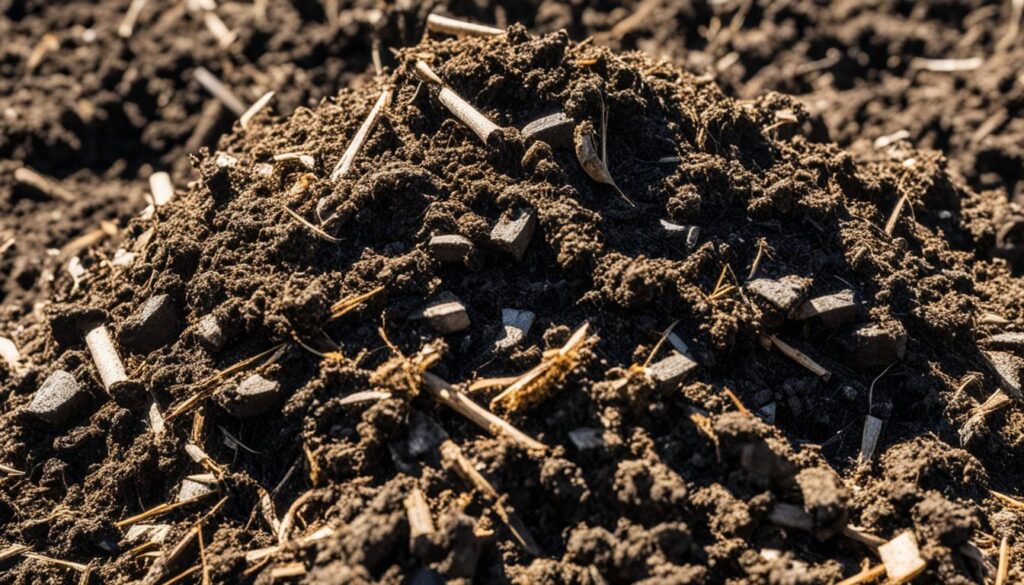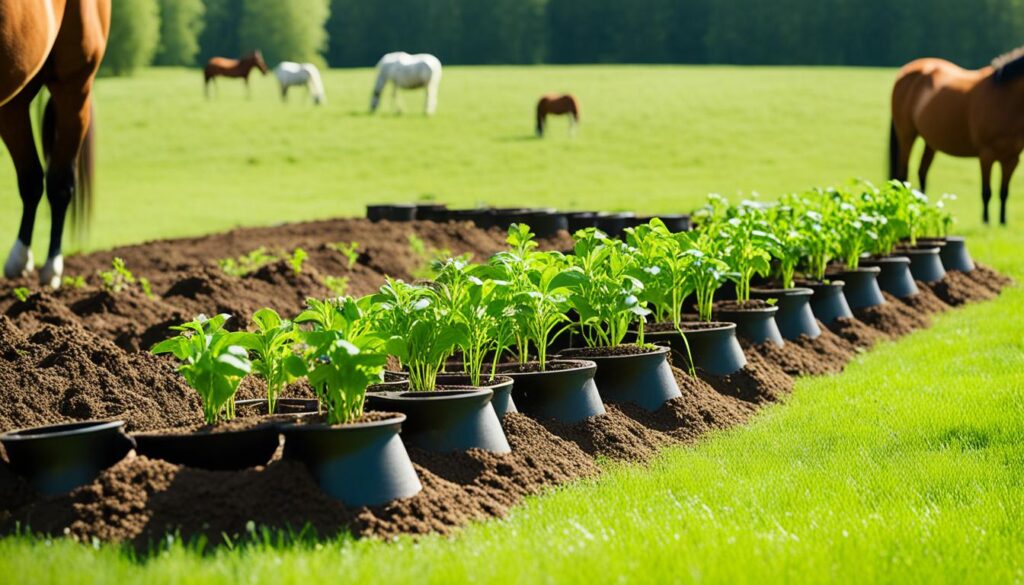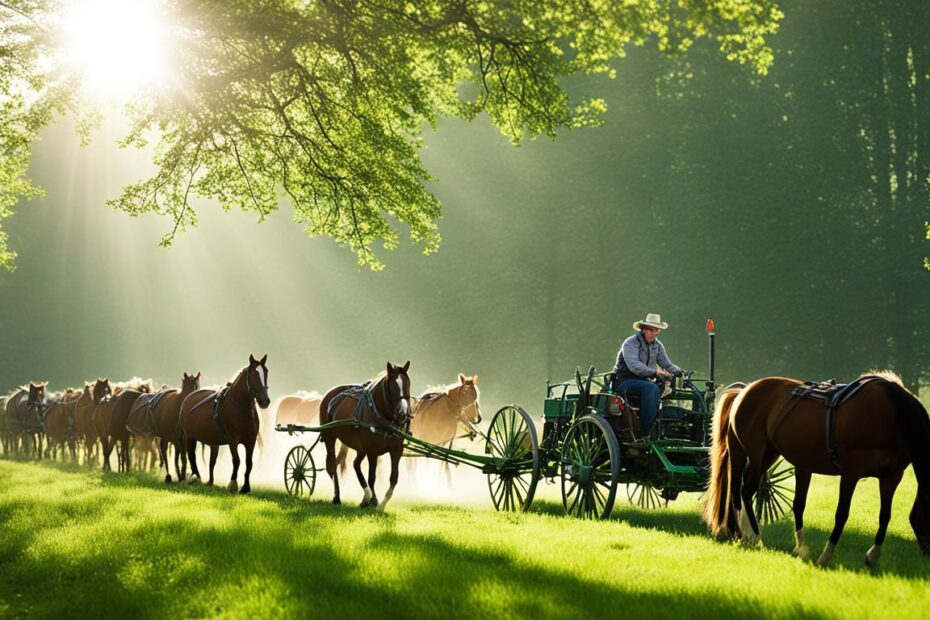In the face of the looming climate crisis, it is imperative that we explore innovative solutions to mitigate the impact of greenhouse gas emissions.
One promising approach lies in harnessing the power of nature’s own resources – horses – to enhance carbon sequestration in grasslands. This article delves into the equine-inspired methods that can revolutionize the way we approach sustainable land management and climate change resilience.
Key Takeaways
- Discover how horse-inspired techniques can boost carbon sequestration in grasslands
- Learn about the benefits of using equine manure for biochar production to improve soil health
- Explore the impact of grazing patterns and rotational grazing methods on soil carbon storage
- Understand the role of healthy grassland ecosystems in climate change mitigation
- Examine the challenges and limitations in implementing horse-inspired carbon sequestration practices
Introduction to Carbon Sequestration in Grasslands
Grasslands are not just picturesque landscapes; they play a vital role in mitigating the effects of climate change. One of the most critical functions of these ecosystems is their ability to sequester and store carbon, a process known as carbon sequestration.
Importance of Carbon Storage in Soils
The soils within grasslands are natural carbon sinks, capable of capturing and storing significant amounts of atmospheric carbon dioxide (CO2). This soil carbon storage is essential for maintaining the overall health and resilience of these ecosystems.
By sequestering carbon, grasslands help to reduce the concentration of greenhouse gases in the atmosphere, a crucial step in addressing the challenges of climate change.
Role of Grasslands in Climate Change Mitigation
In addition to their role in carbon sequestration, grasslands also contribute to climate change mitigation through their ability to regulate local and regional climate patterns.
The extensive root systems and dense vegetation in grasslands help to stabilize soils, prevent erosion, and regulate water cycles, all of which have a positive impact on the local climate.
By understanding the importance of carbon storage and the broader climate benefits of grasslands, we can develop more effective strategies for enhancing their role in mitigating the effects of climate change.
| Key Factors | Importance |
|---|---|
| Carbon Sequestration | Grasslands act as natural carbon sinks, capturing and storing atmospheric carbon dioxide. |
| Soil Carbon Storage | The soils in grasslands play a crucial role in maintaining overall ecosystem health and resilience. |
| Climate Change Mitigation | Grasslands contribute to local and regional climate regulation, helping to address the challenges of climate change. |
The Equine Connection: Harnessing the Power of Horses
In the pursuit of sustainable agriculture, the unique bond between horses and the land holds immense potential. Horses, with their distinct grazing patterns and natural behaviors, can serve as a valuable inspiration for enhancing carbon sequestration in grasslands.
By studying and emulating the equine connection, we can unlock innovative methods to improve soil health and increase the storage of this essential greenhouse gas.
Horses are more than just majestic creatures; they are integral components of the grassland ecosystem. Their grazing habits, hoof patterns, and manure production all contribute to the intricate balance of these environments.
Recognizing the insights that can be gleaned from the equine experience is the first step in harnessing the power of horses for sustainable agriculture.
Grazing Patterns: A Lesson from Horses
Horses have evolved to graze in a manner that promotes the health and resilience of grasslands. Their selective feeding habits, coupled with their natural tendency to move across large areas, can inspire more effective grazing strategies for carbon sequestration.
By studying and emulating the equine grazing patterns, farmers and land managers can design rotational grazing systems that mimic the natural rhythms of the ecosystem, ultimately enhancing soil carbon storage.
Equine Manure: A Valuable Resource
Another key aspect of the equine connection lies in the utilization of horse manure. This organic material, rich in nutrients and carbon, can be transformed into a powerful tool for improving soil health and promoting carbon sequestration.
Through the production of biochar, a highly stable form of carbon, horse manure can be repurposed to enrich soils and contribute to the long-term storage of atmospheric carbon dioxide.
| Equine-Inspired Practices | Benefits for Carbon Sequestration |
|---|---|
| Rotational Grazing | Enhances soil structure, nutrient cycling, and root development |
| Biochar Production from Equine Manure | Improves soil fertility, water-holding capacity, and long-term carbon storage |
| Mimicking Hoof Patterns | Increases soil aeration, microbial activity, and organic matter incorporation |
By harnessing the power of horses and embracing the equine connection, we can unlock a treasure trove of sustainable agriculture practices that can significantly contribute to carbon sequestration in grasslands.
This holistic approach, rooted in the natural rhythms of the land, holds immense promise for addressing the urgent challenge of climate change.
Equine Manure: A Valuable Source of Biochar
Amidst the growing focus on sustainable agriculture, one often overlooked treasure trove lies in the humble equine manure.
This organic byproduct, once seen as a waste, is now gaining recognition as a valuable source of biochar – a game-changing material that can revolutionize soil health and carbon sequestration.
Benefits of Biochar for Soil Health
Biochar, produced through the pyrolysis of organic matter, is a highly porous and carbon-rich substance that offers a multitude of benefits for soil health. When incorporated into the soil, biochar can:
- Improve soil fertility by increasing nutrient retention and availability
- Enhance water-holding capacity, reducing the need for frequent irrigation
- Promote the growth of beneficial microorganisms, fostering a thriving soil ecosystem
- Sequester atmospheric carbon, effectively locking it away in the soil for centuries
Production of Biochar from Equine Waste
Harnessing the power of equine manure, the production of biochar becomes a sustainable and closed-loop process. By carefully burning the manure in a controlled, oxygen-limited environment, the organic matter is transformed into a carbon-rich biochar that can then be incorporated back into the soil.
This not only reduces waste but also creates a valuable soil amendment that amplifies the natural fertility and carbon sequestration potential of the land.
By embracing the potential of equine manure-derived biochar, agricultural communities can unlock a new frontier in sustainable land management, paving the way for a more resilient and eco-friendly future.

Grazing Patterns: Mimicking Nature’s Way
In the quest to enhance carbon sequestration in grasslands, the grazing patterns of horses can offer valuable insights. Rotational grazing, a practice that involves moving livestock, including horses, through different sections of a pasture, holds the key to promoting soil health and carbon storage.
Rotational Grazing Methods
Rotational grazing mimics the natural grazing patterns of wild herbivores, such as horses. By dividing the pasture into smaller sections and regularly moving the animals to new areas, this approach allows the land to rest and recover, promoting the growth of diverse plant species.
This diversity is crucial for building resilient grassland ecosystems and increasing the soil’s capacity to store carbon.
- Divide the pasture into several sections or paddocks
- Rotate the horses or other livestock through these sections, allowing each area to rest and regrow
- Adjust the grazing duration and frequency based on the specific needs of the grassland
- Monitor the impact on soil health, plant diversity, and carbon sequestration rates
By adopting a rotational grazing system inspired by the natural behaviors of horses, farmers and land managers can harness the power of grazing to enhance the carbon storage potential of their grasslands.
This holistic approach not only benefits the environment but also supports the long-term sustainability of agricultural practices.
Horse-Inspired Methods for Enhancing Carbon Sequestration in Grasslands
The key to unlocking greater carbon sequestration in grasslands lies in harnessing the power of horse-inspired methods.
By mimicking the natural grazing patterns and behaviors of these majestic animals, farmers and land managers can implement a suite of sustainable practices that enhance the soil’s ability to store atmospheric carbon.
Central to this approach is the strategic use of equine manure, which can be transformed into a powerful biochar that significantly boosts soil fertility and carbon retention.
Biochar, a charcoal-like substance, not only improves soil structure and water-holding capacity but also provides a long-term carbon sink, effectively locking away atmospheric carbon for centuries.
- Rotational Grazing: Mimicking the natural movement of horses, rotational grazing techniques involve the strategic rotation of livestock across different parcels of land, allowing the grasslands to recover and thrive between grazing periods.
- Manure Management: Collecting and processing equine waste into biochar provides a valuable source of organic matter and nutrients for the soil, while also sequestering carbon that would otherwise be released into the atmosphere.
- Pasture Diversity: Encouraging a diverse mix of grasses, legumes, and other perennial plants in the grasslands can enhance the soil’s carbon storage capacity and improve overall ecosystem resilience.
| Practice | Benefits for Carbon Sequestration |
|---|---|
| Rotational Grazing | Enhances soil structure, increases root biomass, and promotes the growth of deep-rooted perennial plants. |
| Biochar from Equine Manure | Improves soil fertility, water-holding capacity, and long-term carbon storage. |
| Diverse Pasture Ecosystems | Supports a wide range of plant species, which can contribute to greater belowground carbon storage. |
By implementing these horse-inspired methods, farmers and land managers can unlock the true potential of grasslands to act as powerful carbon sinks, helping to mitigate the impacts of climate change while enhancing the overall health and productivity of the land.
Soil Carbon Storage: Measuring the Impact
Evaluating the effectiveness of horse-inspired methods in enhancing soil carbon storage is crucial for understanding their true impact on climate change mitigation.
By quantifying carbon sequestration rates, we can gain valuable insights into the long-term viability of these sustainable agriculture practices.
Quantifying Carbon Sequestration Rates
Measuring the amount of carbon stored in the soil is a complex but essential process. Researchers use a variety of techniques, including soil sampling, laboratory analysis, and modelling, to determine the rate at which carbon is being sequestered in grassland ecosystems.
This data provides a tangible metric for assessing the success of horse-inspired methods in capturing and storing atmospheric carbon.
One key approach is to conduct regular soil surveys, taking samples from different depths and analyzing the organic carbon content.
By tracking changes in soil carbon levels over time, scientists can calculate the rate of carbon sequestration and evaluate the long-term impact of the employed techniques.
In addition to direct soil measurements, researchers may also utilize computer models to simulate and predict carbon sequestration rates. These models incorporate various factors, such as vegetation, climate, and land management practices, to estimate the amount of carbon being stored in the soil.
| Measurement Technique | Advantages | Limitations |
|---|---|---|
| Soil Sampling and Analysis | Provides direct, quantifiable data on soil carbon levels | Time-consuming and requires specialized equipment |
| Computer Modeling | Allows for predictive analysis and scenario testing | Relies on assumptions and may not capture all variables |
By combining these various measurement methods, researchers can gain a comprehensive understanding of the soil carbon storage capabilities of horse-inspired techniques, ultimately guiding the development of more effective climate change mitigation strategies.

Sustainable Agriculture: Embracing Equine-Friendly Practices
As the world grapples with the pressing challenges of climate change and environmental degradation, the adoption of sustainable agriculture practices has become increasingly crucial.
In this context, the utilization of horse-inspired methods for enhancing carbon sequestration in grasslands can play a pivotal role in promoting sustainable agriculture and embracing equine-friendly practices.
Sustainable agriculture is a holistic approach that aims to balance economic, environmental, and social considerations. By incorporating equine-friendly practices into agricultural systems, farmers and landowners can not only contribute to climate change mitigation but also enhance the overall sustainability of their operations.
Benefits of Equine-Friendly Practices
- Improved Soil Health: The use of equine manure as a source of biochar can significantly enhance soil fertility and water-holding capacity, leading to healthier and more productive grasslands.
- Increased Biodiversity: Rotational grazing methods inspired by horses can promote the growth of diverse plant species, fostering a more resilient and ecologically balanced grassland ecosystem.
- Reduced Greenhouse Gas Emissions: By sequestering carbon in the soil, horse-inspired practices can help mitigate the release of greenhouse gases, contributing to the larger goals of sustainable agriculture.
Moreover, the integration of equine-friendly practices into agricultural systems can provide additional benefits, such as enhanced animal welfare, increased resource efficiency, and the preservation of traditional farming techniques.
This holistic approach to sustainable agriculture not only benefits the environment but also supports the livelihoods of farmers and the well-being of the local community.
As the demand for sustainable and environmentally-conscious agricultural products continues to grow, embracing equine-friendly practices can be a strategic step for farmers and landowners to differentiate their offerings, tap into emerging markets, and contribute to the broader movement towards a more sustainable future.
Grassland Ecology: Preserving Biodiversity
Grasslands are more than just expansive green spaces – they are intricate ecosystems teeming with a diverse array of plant and animal life.
Maintaining the health and vitality of these grassland environments is crucial not only for their ecological significance but also for the vital role they play in our global climate.
Importance of Healthy Grassland Ecosystems
Grassland ecosystems support a wide range of species, from the towering grasses that define the landscape to the small, intricate insects that pollinate the blooms.
These habitats are home to unique and sometimes endangered plant and animal life, serving as critical sanctuaries for biodiversity. Preserving the ecological integrity of grasslands is essential for sustaining these delicate webs of life.
Moreover, healthy grassland ecosystems play a crucial role in climate change mitigation. The deep-rooted grasses and diverse plant life in these environments are highly effective at sequestering carbon, helping to offset greenhouse gas emissions and mitigate the effects of global warming.
By implementing horse-inspired methods that promote sustainable land management practices, we can enhance the carbon-storing capabilities of grasslands and contribute to a more sustainable future.
Grassland ecology is a complex and interconnected field, with the well-being of these environments deeply intertwined with the overall health of our planet.
By understanding the importance of preserving biodiversity and promoting sustainable land management practices, we can work to safeguard these vital ecosystems for generations to come.
Challenges and Limitations
Implementing horse-inspired methods for enhancing carbon sequestration in grasslands comes with its fair share of challenges and limitations.
One of the primary concerns is the regional variation in climate, soil conditions, and grazing patterns, which can significantly impact the effectiveness of these techniques. What works well in one location may not necessarily yield the same results in another, requiring careful consideration of local factors.
Additionally, the long-term viability and scalability of horse-inspired methods are crucial considerations. While the initial results may be promising, further research and development are needed to optimize the processes and ensure their sustainability over time.
Factors such as the availability and cost of equine manure, the efficiency of biochar production, and the integration of these methods into existing agricultural practices must be thoroughly evaluated.
| Challenges | Limitations |
|---|---|
| Regional variations in climate and soil conditions | Long-term viability and scalability |
| Availability and cost of equine manure | Integration with existing agricultural practices |
| Efficiency of biochar production | Need for further research and development |
Despite these challenges, the potential benefits of horse-inspired methods for carbon sequestration in grasslands remain compelling.
Continued research, collaboration with local stakeholders, and the ongoing refinement of these techniques can help address the limitations and pave the way for more widespread adoption.
By acknowledging the challenges and working to overcome them, the promise of horse-inspired methods can be realized in the pursuit of sustainable and climate-resilient agricultural practices.
Community Involvement: Engaging Stakeholders
Achieving success in enhancing carbon sequestration in grasslands through horse-inspired methods requires the active involvement and engagement of the community, particularly key stakeholders such as farmers and landowners.
These individuals play a crucial role in driving the adoption of sustainable practices and fostering a collaborative approach to addressing climate change challenges.
Role of Farmers and Landowners
Farmers and landowners are the custodians of the land, and their participation is essential for the implementation of horse-inspired methods for enhancing carbon sequestration.
These stakeholders possess invaluable knowledge of their local ecosystems and can provide valuable insights into the unique challenges and opportunities within their communities.
By actively engaging with farmers and landowners, researchers and policymakers can gain a deeper understanding of the practical realities on the ground.
This collaborative approach can lead to the development of tailored solutions that address the specific needs and concerns of the community, ultimately driving the widespread adoption of these sustainable practices.
| Stakeholder Group | Roles and Responsibilities |
|---|---|
| Farmers | Implement horse-inspired grazing methods Adopt sustainable practices for managing equine waste Serve as ambassadors for promoting community involvement |
| Landowners | Provide access to land for grassland restoration and conservation Collaborate with researchers and policymakers Advocate for policies that support carbon sequestration initiatives |
By fostering a strong community of engaged stakeholders, the potential for enhancing carbon sequestration in grasslands through horse-inspired methods can be truly realized.
This collaborative approach ensures that the unique needs and perspectives of the local community are addressed, leading to the development of sustainable and impactful solutions.
Conclusion
As we conclude this exploration of horse-inspired methods for enhancing carbon sequestration in grasslands, it is clear that these innovative techniques hold immense potential in the fight against climate change.
By harnessing the power of equine manure and mimicking the natural grazing patterns of horses, we can unlock the hidden potential of our grasslands to store and capture more carbon dioxide from the atmosphere.
The findings presented throughout this article underscore the significant benefits of these horse-inspired approaches, including improved soil health, increased biodiversity, and a more sustainable future for our agricultural systems. Embracing these methods can not only contribute to climate change mitigation, but also foster a deeper connection between humans, animals, and the land we share.
Moving forward, it is crucial that we continue to invest in research, foster community engagement, and encourage the widespread adoption of these transformative practices.
By working together, farmers, landowners, and policymakers can drive the transition towards a more resilient and carbon-rich grassland ecosystem, ultimately paving the way for a more sustainable and prosperous future for all.
FAQ
What are the key benefits of using equine manure for biochar production?
Equine manure is a valuable source of biochar, which can significantly improve soil health by enhancing fertility, water-holding capacity, and carbon sequestration.
The production of biochar from equine waste helps to recycle nutrients and reduce the environmental impact of equine waste disposal.
How can rotational grazing methods inspired by horse behavior help enhance carbon sequestration in grasslands?
Rotational grazing, which involves moving livestock, including horses, through different sections of a pasture, can mimic natural grazing patterns and promote soil health and carbon storage. By allowing for periods of rest and regrowth, rotational grazing can enhance the ability of grasslands to capture and store carbon in the soil.
What are the key challenges and limitations associated with implementing horse-inspired methods for enhancing carbon sequestration in grasslands?
Some of the challenges and limitations include regional variations in climate and soil conditions, the need for further research and development to optimize the effectiveness of these techniques, and the need for widespread adoption and community involvement to achieve significant impacts on a larger scale.
How can farmers and landowners play a role in the successful implementation of horse-inspired methods for enhancing carbon sequestration in grasslands?
Farmers and landowners are key stakeholders in the implementation of horse-inspired methods for enhancing carbon sequestration.
Their involvement in adopting sustainable practices, such as using equine manure for biochar production and implementing rotational grazing, is crucial. Engaging these stakeholders and fostering a collaborative approach is essential for driving change and achieving the desired environmental benefits.
How can the preservation of healthy grassland ecosystems contribute to the overall sustainability and resilience of these environments?
Maintaining the ecological diversity and health of grassland ecosystems is crucial. Healthy grasslands support a wide range of plant and animal species, and their preservation can enhance the overall sustainability and resilience of these environments.
The implementation of horse-inspired methods for enhancing carbon sequestration can contribute to the preservation of these vital ecosystems.

